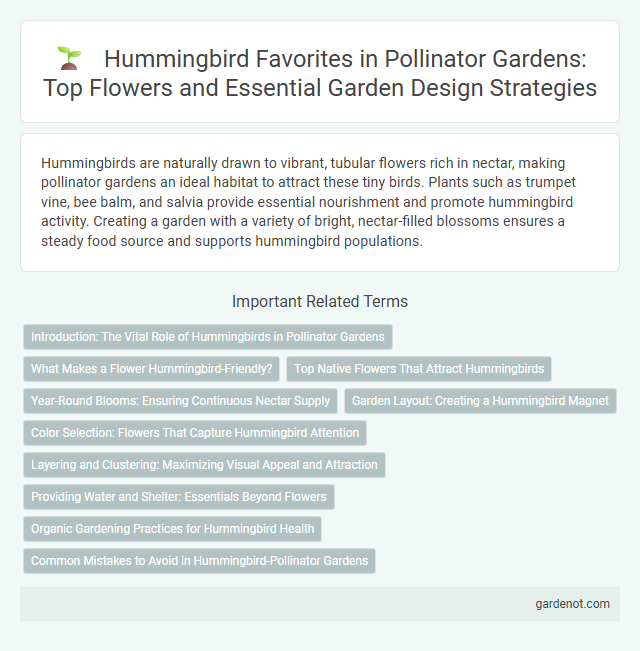Hummingbirds are naturally drawn to vibrant, tubular flowers rich in nectar, making pollinator gardens an ideal habitat to attract these tiny birds. Plants such as trumpet vine, bee balm, and salvia provide essential nourishment and promote hummingbird activity. Creating a garden with a variety of bright, nectar-filled blossoms ensures a steady food source and supports hummingbird populations.
Introduction: The Vital Role of Hummingbirds in Pollinator Gardens
Hummingbirds play a crucial role in pollinator gardens by facilitating the transfer of pollen between vibrant, tubular flowers that specifically attract them with bright reds and oranges. Their rapid wingbeats and hovering ability allow precise access to nectar, promoting the fertilization of native plant species and enhancing biodiversity. Supporting hummingbirds through targeted planting strategies directly boosts the health and productivity of pollinator ecosystems.
What Makes a Flower Hummingbird-Friendly?
Brightly colored, tubular-shaped flowers rich in nectar attract hummingbirds by matching their long, slender beaks and high energy needs. Red, orange, and pink hues are particularly favored because these birds have excellent color vision that highlights these shades. Flowers with ample nectar production, minimal scent, and accessible petals support efficient feeding and encourage frequent visits from hummingbirds.
Top Native Flowers That Attract Hummingbirds
Trumpet vine (Campsis radicans), bee balm (Monarda fistulosa), and columbine (Aquilegia canadensis) are top native flowers that attract hummingbirds due to their tubular shapes and vibrant red hues. These plants provide high nectar content essential for hummingbird energy needs and support local ecosystems by sustaining native pollinators. Incorporating these species into a pollinator garden boosts hummingbird visitation and promotes biodiversity.
Year-Round Blooms: Ensuring Continuous Nectar Supply
Hummingbirds are attracted to a variety of nectar-rich flowers that bloom throughout the year, ensuring a continuous food source even during seasonal shifts. Plants like trumpet vine, salvia, and bee balm provide vibrant, tubular blossoms favored by hummingbirds for easy nectar access. Incorporating a diverse range of flowering species with staggered blooming periods in a pollinator garden supports hummingbird populations by offering year-round nourishment.
Garden Layout: Creating a Hummingbird Magnet
Designing a pollinator garden with tubular, brightly colored flowers such as trumpet honeysuckle and bee balm attracts hummingbirds effectively. Position nectar-rich plants at varying heights to accommodate hummingbirds' feeding patterns and ensure continuous blooms from spring through fall to provide consistent food sources. Incorporate perching spots like thin branches and avoid pesticides to create a safe and inviting habitat for these vibrant pollinators.
Color Selection: Flowers That Capture Hummingbird Attention
Hummingbirds are highly attracted to vibrant red, orange, and fuchsia flowers, as these colors stand out prominently within their visual spectrum. Tubular-shaped blooms such as trumpet vine, cardinal flower, and salvia provide ideal nectar sources that match hummingbirds' long beaks. Selecting a mix of native red and orange flowering plants ensures consistent visitation and supports local hummingbird populations throughout the growing season.
Layering and Clustering: Maximizing Visual Appeal and Attraction
Layering and clustering native tubular flowers like bee balm, salvia, and columbine create vibrant visual depth that maximizes hummingbird attraction and feeding efficiency. Grouping these nectar-rich blooms in staggered heights enhances accessibility while promoting repeated visits, sustaining hummingbird populations. This strategic plant arrangement also boosts garden biodiversity by supporting pollination networks and beneficial insects.
Providing Water and Shelter: Essentials Beyond Flowers
Hummingbirds thrive in pollinator gardens that offer a reliable water source such as shallow birdbaths or misting systems, essential for their hydration and cooling. Providing natural shelter through dense shrubs or small trees creates safe resting and nesting spots, protecting hummingbirds from predators and harsh weather. Incorporating these elements enhances the garden's attraction for hummingbirds, supporting their vital role in pollination.
Organic Gardening Practices for Hummingbird Health
Hummingbirds thrive in pollinator gardens that prioritize organic gardening practices such as avoiding synthetic pesticides and using natural fertilizers like compost to enhance plant health. Native flowering plants rich in nectar, such as bee balm, trumpet vine, and salvia, support hummingbird nutrition and energy levels while ensuring chemical-free food sources. Maintaining a pesticide-free environment promotes hummingbird immune strength and biodiversity, essential for sustainable pollinator ecosystems.
Common Mistakes to Avoid in Hummingbird-Pollinator Gardens
Planting flowers that lack nectar or have overly hybridized blooms can deter hummingbirds from visiting pollinator gardens. Avoid using pesticides and herbicides, as these chemicals can harm hummingbirds and reduce the availability of their insect prey. Ensuring native, tubular, brightly colored flowers like red columbine and trumpet creeper helps attract and support hummingbird populations effectively.
Hummingbird favorite Infographic

 gardenot.com
gardenot.com